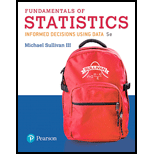
Concept explainers
Putting It Together: Passive Smoke? The following abstract appears in The New England Journal of Medicine:
Background
The relation between passive smoking and lung cancer is of great public health Importance. Some previous studies have suggested that exposure to environmental tobacco smoke in the household can cause lung cancer, but others have found no effect. Smoking by the spouse has been the most commonly used measure of this exposure.
Methods
In order to determine whether lung cancer is associated with exposure to tobacco smoke within the household, we conducted a case-control study of 191 patients with lung cancer who had never smoked and an equal number of persons without lung cancer who had never smoked. Lifetime residential histories including information on exposure to environmental tobacco smoke were compiled and analyzed. Exposure was measured in terms of “smokeryears,’’ determined by multiplying the number of years in each residence by the number of smokers in the household.
Results
Household exposure to 25 or more smoker-years during childhood and adolescence doubled the risk of lung cancer. Approximately 15 percent of the control subjects who had never smoked reported this level of exposure. Household exposure of less than 25 smoker-years during childhood and adolescence did not increase the risk of lung cancer. Exposure to a spouse’s smoking, which constituted less than one third of total household exposure on average, was not associated with an increase in risk.
Conclusion
The possibility of recall blas and other methodologic problems may influence the result of case-control studies of environmental tobacco smoke. Nonetheless, our findings regarding exposure during early life suggest that approximately 17 percent of lung cancers among nonsmokers can be attributed to high levels of exposure to cigarette smoke during childhood and adolescence.
- a. What is the research objective?
- b. What makes this study a case-control study? Why is this a retrospective study?
- c. What is the response variable in the study? Is it qualitative or quantitative?
- d. What is the explanatory variables that may have affected this study?
- e. Can you identify any lurking variables that may have affected this study?
- f. What is the conclusion of the study? Can we conclude that exposure to smoke in the household causes lung cancer?
- g. Would it be possible to design an experiment to answer the research question in part (a)? Explain.
Want to see the full answer?
Check out a sample textbook solution
Chapter 1 Solutions
Fundamentals of Statistics Plus MyLab Statistics with Pearson eText - Title-Specific Access Card Package (5th Edition)
Additional Math Textbook Solutions
Elementary Statistics ( 3rd International Edition ) Isbn:9781260092561
Elementary & Intermediate Algebra
APPLIED STAT.IN BUS.+ECONOMICS
Introductory Statistics
Probability And Statistical Inference (10th Edition)
College Algebra (7th Edition)
- 9. The concentration function of a random variable X is defined as Qx(h) = sup P(x ≤ X ≤x+h), h>0. Show that, if X and Y are independent random variables, then Qx+y (h) min{Qx(h). Qr (h)).arrow_forward10. Prove that, if (t)=1+0(12) as asf->> O is a characteristic function, then p = 1.arrow_forward9. The concentration function of a random variable X is defined as Qx(h) sup P(x ≤x≤x+h), h>0. (b) Is it true that Qx(ah) =aQx (h)?arrow_forward
- 3. Let X1, X2,..., X, be independent, Exp(1)-distributed random variables, and set V₁₁ = max Xk and W₁ = X₁+x+x+ Isk≤narrow_forward7. Consider the function (t)=(1+|t|)e, ER. (a) Prove that is a characteristic function. (b) Prove that the corresponding distribution is absolutely continuous. (c) Prove, departing from itself, that the distribution has finite mean and variance. (d) Prove, without computation, that the mean equals 0. (e) Compute the density.arrow_forward1. Show, by using characteristic, or moment generating functions, that if fx(x) = ½ex, -∞0 < x < ∞, then XY₁ - Y2, where Y₁ and Y2 are independent, exponentially distributed random variables.arrow_forward
- 1. Show, by using characteristic, or moment generating functions, that if 1 fx(x): x) = ½exarrow_forward1990) 02-02 50% mesob berceus +7 What's the probability of getting more than 1 head on 10 flips of a fair coin?arrow_forward9. The concentration function of a random variable X is defined as Qx(h) sup P(x≤x≤x+h), h>0. = x (a) Show that Qx+b(h) = Qx(h).arrow_forward
- Suppose that you buy a lottery ticket, and you have to pick six numbers from 1 through 50 (repetitions allowed). Which combination is more likely to win: 13, 48, 17, 22, 6, 39 or 1, 2, 3, 4, 5, 6? barrow_forward2 Make a histogram from this data set of test scores: 72, 79, 81, 80, 63, 62, 89, 99, 50, 78, 87, 97, 55, 69, 97, 87, 88, 99, 76, 78, 65, 77, 88, 90, and 81. Would a pie chart be appropriate for this data? ganizing Quantitative Data: Charts and Graphs 45arrow_forward10 Meteorologists use computer models to predict when and where a hurricane will hit shore. Suppose they predict that hurricane Stat has a 20 percent chance of hitting the East Coast. a. On what info are the meteorologists basing this prediction? b. Why is this prediction harder to make than your chance of getting a head on your next coin toss? U anoiaarrow_forward
 Glencoe Algebra 1, Student Edition, 9780079039897...AlgebraISBN:9780079039897Author:CarterPublisher:McGraw Hill
Glencoe Algebra 1, Student Edition, 9780079039897...AlgebraISBN:9780079039897Author:CarterPublisher:McGraw Hill Big Ideas Math A Bridge To Success Algebra 1: Stu...AlgebraISBN:9781680331141Author:HOUGHTON MIFFLIN HARCOURTPublisher:Houghton Mifflin Harcourt
Big Ideas Math A Bridge To Success Algebra 1: Stu...AlgebraISBN:9781680331141Author:HOUGHTON MIFFLIN HARCOURTPublisher:Houghton Mifflin Harcourt College Algebra (MindTap Course List)AlgebraISBN:9781305652231Author:R. David Gustafson, Jeff HughesPublisher:Cengage Learning
College Algebra (MindTap Course List)AlgebraISBN:9781305652231Author:R. David Gustafson, Jeff HughesPublisher:Cengage Learning



